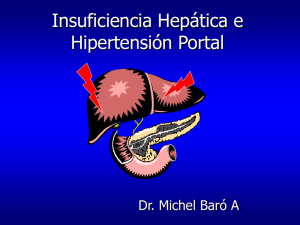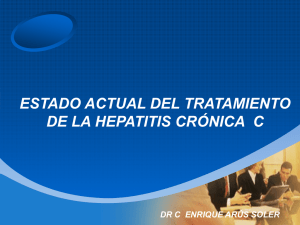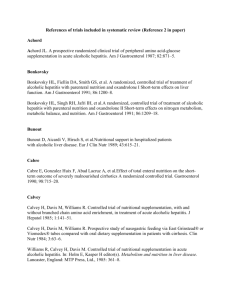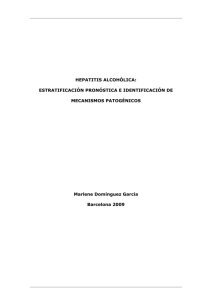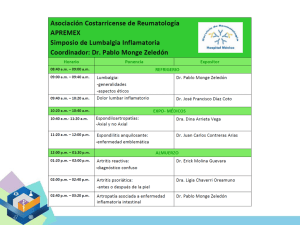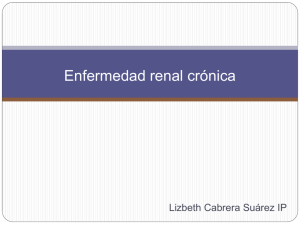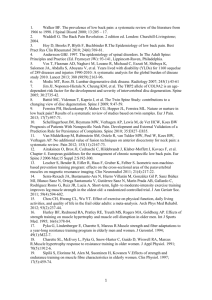HEPATITIS CRÓNICA VÍRICA - Grupo de Infecciosas SoMaMFYC
advertisement
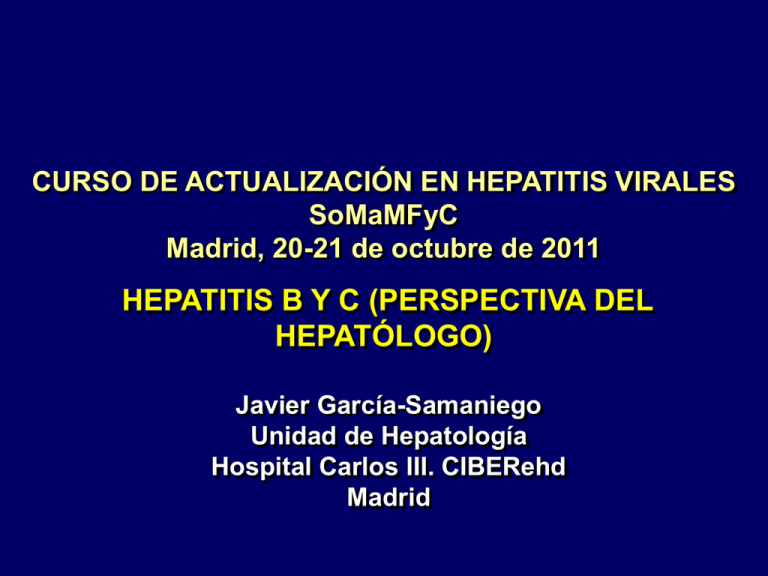
CURSO DE ACTUALIZACIÓN EN HEPATITIS VIRALES SoMaMFyC Madrid, 20-21 de octubre de 2011 HEPATITIS B Y C (PERSPECTIVA DEL HEPATÓLOGO) Javier García-Samaniego Unidad de Hepatología Hospital Carlos III. CIBERehd Madrid Hepatitis B Hepatitis B virus (HBV) • Hepadnaviridae member that primarily infects liver cells • 100 times more infective than HIV • Found in blood and body fluids – Able to survive in dried blood for > 1 week Ott MJ et al. J Pediatr Health Care 1999; 13(5):211–216 Ribeiro RM et al. Microbes Infect 2002; 4:829–835 CDC. MMWR 2003; 52:1–33 IN MEMORIAM Doctor Baruch Blumberg (1925-2011) • Descubridor del Ag de superficie del VHB • Premio Nobel de Medicina en 1976 • Presidente de la American Philosophical Society Geographic prevalence of chronic hepatitis B 8% – High 2–8% – Intermediate <2% – Low World Health Organisation. Geographical Prevalence of HBsAg. Data 1996 (unpublished) http://www.who.int/vaccines-surveilllance/graphics/htmls/hepbprev.htm http://www.who/cds/csr/lyo/2002.2 Changing prevalence of hepatitis B PORTUGAL SPAIN CDC data: prevalence 2–8% WHO estimate: 1–2% HBsAg+ CDC data: prevalence 2–8% WHO estimate: 1.2% HBsAg+ Current estimate: ~1.5% with some regional variation. 0.9% HBsAg+ in central Portugal in 1993. Overall decreasing prevalence apart from areas with high levels of immigration Current estimate: ~1.25% 1993 ~1.2% prevalence (blood donors) reduced to 0.7% in 2003 (general public) Hepatitis B nomenclature Name Abbreviation Definition/Comment Hepatitis B Surface Antigen HBsAg Protein indicating infection Hepatitis B e Antigen HBeAg Antigen correlating with HBV replication and infectivity; levels lower in patients with precore and core mutations Hepatitis B Core Antigen HBcAg Detected in liver tissue Chronic Hepatitis B CHB Defined as the persistence of HBsAg for > 6 months HBV deoxyribonucleic acid HBV DNA Indicates active viral replication HBeAg-negative CHB e-CHB Chronic hepatitis B with active viral replication, but low or undetectable HBeAg CDC. MMWR 2003; 52:1–33 Mahoney FJ Clin Microbiol Rev 1999; 12:351–366 Funk ML et al. J Viral Hepat 2002; 9:52–61 Phases of chronic hepatitis B HBeAg Status Immune Tolerant Phase HBeAg Immune Active Phase (Chronic Hepatitis B) HBeAg or anti-HBe Non-replicative Phase (Inactive HBsAg Carrier) Anti-HBe Lok & McMahon. Hepatology 2007; 45: 507-39 HBV DNA Levels (IU/mL) High (> 105) High (> 105) Low (< 104) ALT Levels Liver Histology Normal Normal or minimal inflammation Elevated Chronic inflammation Normal Normal or minimal inflammation HBeAg-negative CHB characteristics • • • • • • • • • Growing prevalence Liver disease typically advanced Male Age range 36–45 years Sustained spontaneous remission is rare Persistent or intermittent HBV replication Fluctuations in ALT and viraemia levels Severe liver necroinflammation Progressive fibrosis – ~40% of patients in some studies have cirrhosis Hadziyannis SJ et al. N Engl J Med 2003; 348:800–807 Fattovich G Semin Liver Dis 2003; 23:47–58 ¿Hay cambios en la epidemiología de la infección por VHB en Europa? Nuevos pacientes Pacientes “viejos” Inmigrantes ↑Casos HBeAg-positivo Edad < 35 años Diferentes genotipos Coinfecciones (VHC,VIH) Mayoría naïves tto. Nativos 90% HBeAg-negativo Edad > 45 años Mayoría genotipo D Pocas coinfecciones (VHC o VHD) Enfermedad avanzada Mayoría tratados Edad 10 20 30 40 50 60 70 80 Role of HBV DNA Testing • Diagnosis of HBV infection • Disease prognosis (risk for development of cirrhosis and hepatocellular carcinoma) • Pre-treatment evaluation • Decision to treat • Treatment indication (IFN vs analogues) • Monitoring of virologic responses to therapy • Assessment of treatment failure and resistance selection Significance of HBV DNA/viral replication Presence of HBV DNA/viral replication precedes Elevated ALT Worsening histology HCC High Baseline HBV DNA Associated with Increased Risk of Cirrhosis and HCC Cumulative incidence of HCC at year 13 follow-up[1] (N = 3,653) Cumulative incidence of cirrhosis at year 13 follow-up[2] (N = 3,582) Baseline HBV DNA (copies/mL) Chen et al. JAMA. 2006;295:65-73. Iloeje et al. Gastroenterology. 2006;130:678-686. ¿Qué ensayos debemos usar para cuantificar el DNA VHB? Technical Achievements of Real-time PCR • No carryover contamination • Improved analytical sensitivity • Extended range of linear quantification • Precision and reproducibility • High throughput through automation Dynamic Ranges of Quantification of HBV DNA Assays 10 Amplicor HBV Monitor v2.0 (Roche) HBV Hybrid-Capture II (Digene) Ultra-sensitive HBV Hybrid-Capture II Versant HBV DNA 3.0 (bDNA, Siemens) Cobas Taqman HBV (Roche) RealArt HBV LC PCR (Artus Biotech) Abbot Real-time HBV (Abbott) Versant HBV DNA 1.0 (kPCR, Siemens)* *in development 102 103 104 105 106 107 108 109 Hepatitis C Diagnóstico serológico de la hepatitis C • Anticuerpos anti-VHC • ARN-VHC (marcador directo de replicación) • Genotipo (característica molecular propia del virus circulante) • Antígeno del core del VHC (marcador de replicación activa; correlación con niveles circulantes de ARN-VHC) Anti-HCV Antibody Testing for HCV ELISA screening tests • Detect circulating HCV antibodies • Sensitivity: 97% to 100% • Positive predictive value – 95% with risk factors and elevated ALT – 50% without risk factors and normal ALT False Positives More Likely in: False Negatives More Likely in: Patients with low risk of HCV infection Severely immunosuppressed patients Transplantation recipients Patients with chronic renal failure on dialysis HIV-positive patients NIH Consensus Statement. Available at: http://consensus.nih.gov/2002/2002HepatitisC2002116html.htm. Accessed May 7, 2009. Carithers RL Jr, et al. Semin Liver Dis. 2000;20:159-171. Pawlotsky JM. Hepatology. 2002;36(suppl 1):S65-S73. Utilidad de los tests de ARN VHC • Diagnóstico de infección activa por VHC • Diagnóstico precoz de la infección aguda • Diagnóstico de la infección perinatal • Evaluación pre-tratamiento • Monitorización de la respuesta al tratamiento AASLD HCV RNA Testing Recommendations “HCV RNA testing should be performed in: a) Patients with a positive anti-HCV test. b) Patients for whom antiviral treatment is being considered, using a sensitive quantitative assay. c) Patients with unexplained liver disease whose anti-HCV test is negative and who are immunocompromised or suspected of having acute HCV infection.” Ghany MG, et al. Hepatology. 2009;49:1335-1374. Quantitative Assays for Serum/Plasma HCV RNA Method IU/mL Conv Factor (copies/mL) Dynamic Range (IU/mL) FDA Approved Amplicor HCV Monitor Manual RT-PCR 0.9 600-500,000 Y Cobas Amplicor HCV Monitor V2.0 Semiautomated RT-PCR 2.7 Versant HCV RNA 3.0 Assay Semiautomated bDNA signal amplification 5.2 615-7,700,000 Y LCx HCV-RNA Quantitative Assay Semiautomated RT-PCR 3.8 25-2,630,000 N SuperQuant Semiautomated RT-PCR 3.4 30-1,470,000 N Semiautomated real time PCR NA 43-69,000,000 Y Semiautomated RT-PCR NA 12-100,000,000 N Assay Cobas Taqman HCV Test RealTime 600-500,000 Diagnosis, management, and treatment of hepatitis C: an update, Ghany MG, et al. Hepatology. 2009;49:1335-1374. Copyright © 2009. Reproduced with permission of John Wiley & Sons, Inc. Y Interpretation of HCV Laboratory Tests If anti-HCV positive and HCV RNA positive – Acute or chronic HCV infection depending on clinical context If anti-HCV positive and HCV RNA negative – Resolution of HCV; acute HCV infection during period of low-level viremia If anti-HCV negative and HCV RNA positive – Early acute HCV infection; chronic HCV infection in setting of immunosuppression; false-positive HCV RNA test If anti-HCV negative and HCV RNA negative – Absence of HCV infection Ghany MG, et al. Hepatology. 2009;49:1335-1374. EVALUACIÓN DE LA FIBROSIS HEPÁTICA EN LA HEPATITIS CRÓNICA VÍRICA • Pronóstico (¿hay cirrosis?) • Decisiones terapéuticas (¿existe fibrosis?) Confirmar el diagnóstico clínico Riesgos asociados: hemorragia <1% muerte 0,01 – 1%3 Evaluar la gravedad de la fibrosis y la necroinflamación1,2 Papel de la biopsia hepática en la infección por VHC Evaluar posibles procesos patológicos concomitantes (como enfermedad hepática alcohólica, EHNA)1,2 Puede ayudar en la toma de decisiones Evaluar la intervención terapéutica1 1. NIH Consensus Statement Online. Management of hepatitis C. 2. British Liver Trust Information Service. A guide to liver function tests. 3. Canadian Liver Foundation. HEPATITIS CRÓNICA VÍRICA Biopsia Hepática – Diagnóstico Histológico Knodell et al Hepatology, 1981 IAH (0-22) Inflamación portal Necrosis periportal Necrosis lobulillar Fibrosis 0-4 0-10 0-4 0-4 HEPATITIS CRÓNICA VÍRICA Biopsia Hepática – Diagnóstico Histológico P. Scheuer J Hepatol 1991 GRADO Clasif. METAVIR Hepatology 1996 ESTADIO GRADO P0 L0 F0 - - F0 A0 P1 L1 F1 - portal - F1 A1 P2 L2 F2 - periportal - F2 A2 P3 L3 F3 - septal - F3 A3 P4 L4 F4 - cirrosis - F4 HC (P3,L2,F2) no ESTADIO HC (A1,F2) HEPATITIS CRÓNICA – F1 HEPATITIS CRÓNICA – F2 HEPATITIS CRÓNICA – F4 Inconvenientes de la biopsia hepática • Complicaciones (0,6% graves y mortalidad 1/10.000) • Mal aceptada por el paciente • Variabilidad inter e intraobservador • Error de muestra • Difícilmente repetible • Coste Biopsia hepática: ¿gold standard? 1/50.000 de tejido hepático Regev et al. Am J Gastroenterol 2002; 97: 2614-8 Precisión diagnóstica de la biopsia hepática • Subestimación cirrosis: 10%-25% • Discordancias = 33% (lóbulo dcho vs izdo) Colloredo et al. J Hepatol 2003; 39: 239-44. Regev et al. Am J Gastroenterol 2002; 97:2614-8 MÉTODOS NO CRUENTOS DE EVALUACIÓN DE LA FIBROSIS 1. MARCADORES SÉRICOS E ÍNDICES BIOQUÍMICOS – DIRECTOS – INDIRECTOS 2. PRUEBAS DE IMAGEN ULTRASONOGRAFÍA TAC RMN SPECT / PET ELASTOGRAFÍA (FIBROSCAN®) 3. OTROS – GENÉTICOS – MOLECULARES (microarray, proteómicos, glicómicos) Marcadores séricos de fibrosis Test Elementos Cutoff Sensibilidad Especificidad APRI AST PLT < 0.5 > 1.5 91 41 47 95 FORNS Edad, colest, GGT, PLT < 4.2 > 6.9 94 30 51 95 FIBROTEST APOA1,GGT A2MG,Bt, glob, 2glob 0.3 87 59 FIB-4 Age, AST ALT, PLT < 1.45 > 3.25 70 22 74 97 Transient elastography: FibroScan The probe induces an elastic wave through the liver The velocity of the wave is evaluated in a region located from 2.5 to 6.5 cm below the skin surface The velocity of the wave is related to liver stiffness and to fibrosis Explored volume 2.5 cm 1 cm 4 cm LB : 1/50,000 of the liver FibroScan : 1/500 of the liver The harder the tissue, the faster the wave propagates FIBROSCAN •Inocuo/Sencillo •Duración menor de 5 minutos •Grado de fibrosis desde F0 a F4 FibroScan: rigidez hepática y fibrosis 75 F4 12-14 F3 9-10 F2 7-8 kPa 2,5-75 kPa Limitaciones del FibroScan • Obesidad mórbida • Espacios intercostales estrechos • Ascitis FibroScan in HCV patients Chronic HCV infection N = 251 Ziol et al. Hepatology 2005; 41: 48-54 F≥2 0.84 F≥3 0.90 F=4 0.94 FibroScan in HBV patients 1 Sensitivity 0,8 AUROC F≥2 : 0.82 0,6 F≥3 : 0.92 0,4 F=4 : 0.90 F01 versus F234 F012 versus F34 0,2 F0123 versus F4 N=170 0 0 0,2 Marcellin P et al. AASLD 2005 0,4 0,6 1 - Specificity 0,8 1 HEPATITIS CRÓNICA VÍRICA Evaluación “incruenta” de la fibrosis Fibrotest® APRI Fibroscan® Discrepancia Biopsia hepática Castéra et al. Gastroenterology 2005; 125: 343-59
